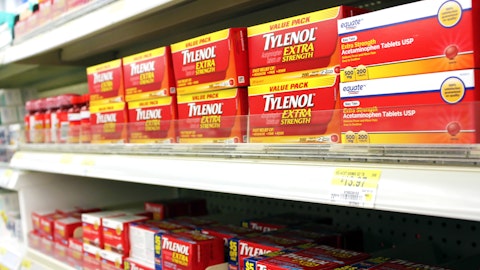If you don’t currently own Pfizer Inc. (NYSE:PFE), and are looking to add some shares quickly, one way to use cash covered puts is to sell a short duration (in this case one month) put that is very close to the current price.
This is because shorter-term contracts usually pay more premium per day, and since you are looking to start an initial position, you don’t mind getting assigned shares if the share price drops below $33.50. After all it’s a great company, that’s already seemingly undervalued, and by selling a Nov 11th $33.50 put, you are getting $123 per contract up front.
That means that, should Pfizer fall under $33.50 over the next month, you would end up buying shares for $33.50 – $1.23 = $32.27. That’s a 3.9% discount to the already cheap shares, and a very nice 3.7% yield.
If the share price stays above $33.50, then the contract expires worthless and the $123 premium per contract represents a very nice return of $123 / $3,227 ($3,350 cost to buy 100 shares at $33.50 minus the premium already received). That’s equal to a 3.8% return over 35 days, or 47.7% annualized income yield.
Now keep in mind that this APR is only for the 35 days of the contract. To actually earn that high of a yield would require selling 12 such contracts, one each month, for the exact same terms, and each of them expiring worthless; a highly unlikely event. Nonetheless, a 3.8% return to sit on your money for a month is a very nice return; thus showing the potential income generating power of cash secured puts.
But let’s say that you already own Pfizer Inc. (NYSE:PFE), and aren’t necessarily eager to buy more unless it’s at a much steeper (i.e. less likely) discount.
In that case you could sell a March 17 $29 put, which expires in just over five months, and pays $0.55 per share, or $55 per contract. While this is far less than the previous example, keep in mind that because this strike price is so “far out of the money” (below the current share price), the chances of actually buying these shares is less likely. Thus the risk of assignment is lower, and you earn a proportionally lower annualized yield of 4.4%.
Then again, that’s still a nice yield in today’s world, where even 50 year Swiss bonds can have negative yields. And don’t forget that if you do end up owning those shares it will be at a 15.3% discount to the current price, which means a 4.2% dividend yield.
Follow Pfizer Inc (NYSE:PFE)
Follow Pfizer Inc (NYSE:PFE)
Covered Call Example: Johnson & Johnson (NYSE:JNJ)
The data below is from October 6, 2016:
| Call Option | Premium / Share | Implied Sell Price | Premium To Current Price | Premium Yield | Annualized Premium Yield |
| Nov 11 $119 | $1.94 | $120.94 | 1.5% | 1.6% | 18.4% |
| Nov 11 $124 | $0.41 | $124.41 | 4.4% | 0.3% | 3.6% |
| Apr 21 $120 | $3.99 | $123.99 | 4.0% | 3.4% | 6.4% |
| Apr 21 $125 | $2.09 | $127.09 | 6.6% | 1.8% | 3.3% |
Note that the premium offered for these calls is a lot lower than that of Pfizer’s puts. That is mainly for two reasons.
First, put premiums take into account dividends, while call premiums don’t. That’s to compensate you for the fact that by selling calls you are forgoing immediate ownership of the dividend paying shares.
With a covered call, you already own the shares and will get the dividend unless the share price is above the strike price and the owner of the option wants to exercise his right to buy your shares before the expiration date to get the dividend.
The second reason is that Johnson & Johnson (NYSE:JNJ) is less volatile than Pfizer, as represented by its lower beta. There are several factors that affect option premiums but the largest is volatility. That makes sense because selling options is a form of insurance. Volatility is a proxy for risk, and as with insurance, premiums are higher if the risk is larger.
Let’s say you think that Johnson & Johnson has run up too far, too fast, and is currently overvalued, especially given its decent, but slowing dividend growth prospects (even despite its status as a dividend aristocrat).
Depending on whether you are overweight the stock and looking to unload quickly, or merely wouldn’t mind taking some profits off the table, you can use options to get a better selling price, or generate decent income if the share price either stays flat, or falls.
For example, let’s say you are overweight JNJ and have a decent alternative investment you wouldn’t mind investing in. In such a case you might not mind your shares being called away, especially since it would be at a higher price. So you could sell a November 11 $119 call, which pays $194 per contract and would result in a slightly higher sell price of $120.94.
Because you are giving up the ability to sell your 100 shares at the current value of $119.18 per share (as of 10/6/16), or $1,918, your yield for this month long contract is $194 / $1918, or 1.6%; equivalent to an annualized yield of 18.4%.
If the price of JNJ falls below $119 then you get to keep the premium, and your shares. If the price rises above it, then your shares will get called away (i.e. sold) to the option owner for $119. But since you received $1.94 per share in upfront premium your effective selling price is $120.94, a tad higher than what you could sell the stock for today.
But what if you aren’t so eager to sell unless it’s at a much higher premium? If you’re okay with trimming your holdings by 100 shares per contract you can sell an April 21 $125 call and receive $2.09 per share in premium. This is a $209 / $1918 = 1.8% return over 6.5 months, or 3.3% annualized.
While that doesn’t sound like much, remember that you should only sell a call if you think the underlying stock isn’t likely to rise very much by expiration. So in this case you think that the chances of Johnson & Johnson (NYSE:JNJ) rising are small, and you are getting paid 3.3% APR to not immediately sell your shares, and collect 1-2 dividends while you wait to see how the contract plays out.
Follow Johnson & Johnson (NYSE:JNJ)
Follow Johnson & Johnson (NYSE:JNJ)





